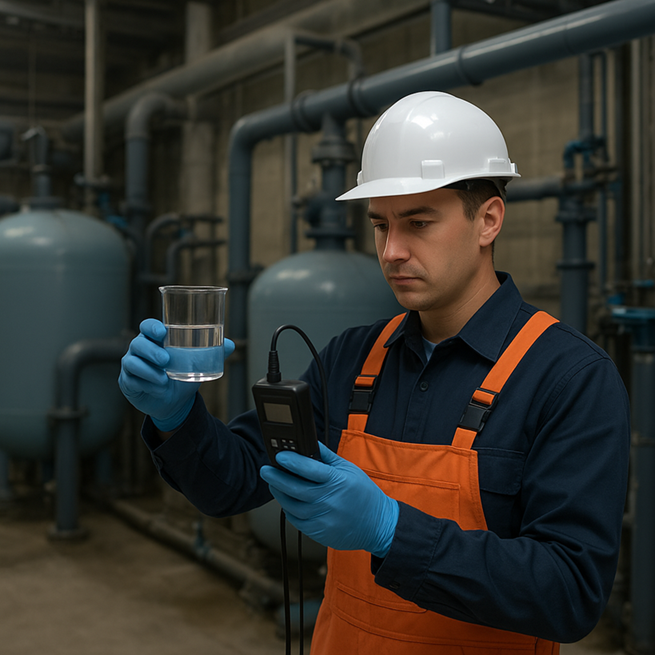
Is Water Quality Testing Important in Industrial Water Treatment?
Water quality testing is a critical aspect of industrial water treatment in factories, playing a fundamental role in ensuring the safety, efficiency, and compliance of water used in manufacturing processes. With factories increasingly relying on water for a range of functions, including cooling, treatment, and cleaning, maintaining high water quality is essential to preventing operational disruptions and meeting regulatory standards.
Prominent industries that prioritize water quality include pharmaceuticals, food and beverage, and chemical manufacturing, where even minor contaminants can compromise product safety and lead to serious health risks. The importance of water quality testing extends beyond operational concerns to include public health and environmental protection. Contaminated water can lead to serious health problems, including gastrointestinal illnesses, and also impacts aquatic ecosystems and contributes to biodiversity loss.
With increasingly stringent regulatory frameworks, such as the Safe Drinking Water Act (SDWA) and the National Primary Drinking Water Regulations (NPDWR), factories must adhere to applicable quality standards to avoid legal repercussions and reputational damage. Various water testing methodologies are used to monitor physical, chemical, and biological contaminants, ensuring that industrial water meets safety and operational standards. Regular testing not only helps ensure compliance with health regulations but also enhances operational efficiency by mitigating the risks associated with waterborne contaminants.
Overview of Water Treatment in Factories
Industrial water treatment is essential to ensure the quality and safety of water used in various manufacturing processes. Factories use water for multiple purposes, including cooling, washing, processing, and as a component in products, making water quality critical for operational efficiency and compliance with health regulations.
Importance of Water Quality
Maintaining high water quality is crucial in many industries, such as pharmaceuticals, food and beverages, and chemical manufacturing. In the pharmaceutical industry, for example, water must be free of contaminants to ensure the safety and efficacy of medicines. Similarly, in the food and beverage sector, water quality directly impacts product safety and taste, necessitating regular testing to prevent contamination and maintain regulatory standards. Poor water quality can lead to significant production disruptions, equipment damage, and potential regulatory penalties, highlighting the need for rigorous water treatment protocols.
Water Treatment Methods
Various water treatment methods are used in industrial settings, including raw water treatment systems that prepare source water for applications such as heating and cooling. The choice of treatment method depends on factors such as the specific contaminants present, the requirements of the industrial process, and available resources.
Advanced technologies, such as smart sensors and IoT monitoring systems, are increasingly used to manage water quality in real time, facilitating better decision-making and regulatory compliance.
Regulatory Compliance
Factories are subject to strict regulatory frameworks that dictate water quality standards to protect public health and the environment. Compliance with the Environmental Protection Agency (EPA) and other local regulations is vital for manufacturers, especially in high-risk industries such as pharmaceuticals and food production, where water quality must meet stringent health standards. Failure to comply with these regulations can result in hefty fines and reputational damage.
Water Quality Testing Methods
Water quality testing is essential to ensure that water used in industrial processes meets safety and operational standards. Various methods are used to analyze the physical, chemical, and biological properties of water to determine its quality and suitability for manufacturing applications.
Types of Water Testing Methods
There are three main methods of water testing analysis: physical, chemical, and biological. The choice of the appropriate method depends on the specific industry requirements, the water source, and sustainability goals.
Physical Water Testing Methods
Physical water testing involves evaluating observable water properties that may affect industrial processes, such as:
- Color: Visual inspection of water color can indicate the presence of suspended or dissolved solids. Certain colors may be associated with common pollutants, providing an initial understanding of potential treatment needs.
- Temperature: Water temperature affects its behavior in industrial environments and can impact the efficiency of equipment and processes.
Chemical Water Testing Methods
Chemical analysis is a fundamental aspect of water quality testing, focusing on identifying and measuring chemical contaminants.
- Ammonia, chloride ions, nitrite, nitrate, and phosphate: These chemical parameters are essential for understanding water quality. For example, high levels of chloride ions can indicate contamination and lead to pipeline corrosion, impacting maintenance costs and equipment lifespan.
- Dissolved oxygen (DO): Monitoring dissolved oxygen is crucial in various industrial applications, such as steel mills, where it helps assess corrosion rates and biological treatment processes. Excessive or insufficient oxygen levels can pose operational challenges.
Read also: What chemicals are used in water treatment?
Biological water testing methods
Biological testing examines the presence of microorganisms in water, ensuring its safety for consumption and industrial use. An example of biological testing is bacterial testing. This test focuses on harmful bacteria, such as Escherichia coli.
Water quality can be affected by various factors, including bacteria, viruses, and parasites, which can pose significant health risks. Bacterial levels are influenced by environmental factors such as temperature and pH, making comprehensive testing essential for accurate assessment.
Importance of Comprehensive Testing
Using a combination of testing methods ensures a thorough evaluation of water quality, guiding effective management practices in industrial environments. Regular monitoring and analysis not only help ensure compliance with safety regulations but also enhance operational efficiency by preventing problems related to water contamination and equipment failures.
Learn more about the different types of water quality tests
Major Contaminants Monitored
In the context of water quality testing, it is essential to monitor various contaminants to ensure safety and compliance with health standards. Contaminants can generally be classified into three main groups: microbial, chemical, and physical.
Microbial Contaminants
Microbial contaminants include bacteria, viruses, and parasites that can pose serious health risks if ingested. Common microbial contaminants found in water sources include Escherichia coli (E. coli) and Salmonella, which often indicate fecal contamination.
Total coliform bacteria are frequently used as a standard measure of microbial contamination, and their presence can indicate the potential presence of pathogenic microorganisms in the water supply. Contamination from sources such as wastewater treatment plants and agricultural runoff can lead to gastrointestinal illnesses, making monitoring these contaminants a public health priority.
Chemical Pollutants
Chemical pollutants in water can be classified into two categories: inorganic and organic. Inorganic pollutants include salts and heavy metals, such as arsenic and lead. Which may originate from natural sources or human activities such as industrial discharges and agricultural runoff.
Organic pollutants, which include pesticides, herbicides, and volatile organic compounds (VOCs). May enter water sources through agricultural practices, urban stormwater runoff, and industrial processes. Monitoring these pollutants is crucial due to their impact on human health and water quality. This leads to adverse health effects ranging from acute poisoning to long-term health problems such as cancer.
Physical Pollutants
Physical pollutants include sediment, suspended solids, and turbidity, which can affect water clarity and overall quality. High turbidity levels can indicate the presence of other pollutants and can negatively impact aquatic ecosystems and water treatment processes. Monitoring physical pollutants is essential, not only for aesthetic reasons but also to prevent equipment damage in industrial settings. This damage can lead to increased maintenance costs and downtime due to blocked pipes and malfunctioning filtration systems.
Nervous Pollutants
In addition to primary pollutants, noxious pollutants, such as hydrogen sulfide and iron bacteria, can also be monitored. While these pollutants may not pose immediate health risks. Their presence can affect water quality and aesthetic characteristics. Such as taste and odor, leading to consumer dissatisfaction.
























